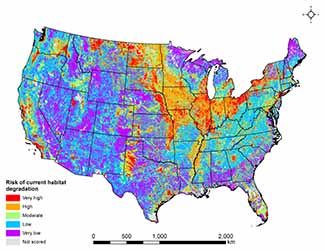MSU scientist leads assessment of country’s inland stream fish habitats
Add Summary
At first glance, people and fish don’t seem to have much in common. But the more than 322 million people in the United States and the more than 3,000 species of fish all depend on the same water for survival. The latest assessment report from the National Fish Habitat Partnership offers insights on the effect humans have had on fish habitat and fish sustainability. Dana Infante, Michigan State University associate professor of fisheries and wildlife and director of the Aquatic Landscape Ecology Lab in the MSU Center for Systems Integration and Sustainability, was one of the report’s authors and led the inland stream assessment team.
The latest assessment report from the National Fish Habitat Partnership offers insights on the effect humans have had on fish habitat and fish sustainability. Dana Infante, Michigan State University associate professor of fisheries and wildlife and director of the Aquatic Landscape Ecology Lab in the MSU Center for Systems Integration and Sustainability, was one of the report’s authors and led the inland stream assessment team.
“This report is a tool to raise public awareness on the state of and threats to our nation’s rivers,” Infante explained. “It gives managers and decision-makers critical information on where and how to conserve and restore river fish habitats. The scale is unprecedented in that results are available for all 50 states. We are very proud of the assessment outcomes and acknowledge contributions from partners across the nation, including giving us feedback on our approach and sharing data.”
The report, “Through a Fish’s Eye: The Status of Fish Habitats in the United States 2015,” summarizes the results of a nationwide assessment of human effects on fish habitat in the rivers and estuaries of the United States. The assessment assigns a risk of current habitat degradation scores for watersheds and estuaries across the nation and within 14 sub-regions. The results also identify the major sources of habitat degradation. 
This report updates and revises the 2010 “Status of Fish Habitats in the United States” report. The 2015 report provides even greater detail on the condition of fish habitat in the United States. The 2010 inland streams assessment characterized fish habitat condition using stream fish data from more than 26,000 stream reaches, while the 2015 assessment is based on fish data from more than 39,000 stream reaches nationally. To increase accuracy, the 2015 inland stream assessment incorporates 12 additional human disturbance variables into the fish analysis.
The 2015 report is a web-based application that allows users to navigate findings and explore interactive maps of results by region or nationally, as well as download sections of the report as PDF documents or save and share a link that is unique to a subsection of interest.
Other members of Infante’s inland assessment team are: Wesley Daniel, post-doctoral research associate in Infante’s lab, who conducted analyses to create assessment scores; and Ralph Tingley, doctoral student; Jared Ross, master’s student; and research assistants Kyle Herreman and Arthur Cooper who supported development and management of the extensive GIS datasets required for the analysis.
“This report serves as a good indicator to identify areas where habitat conservation efforts are most critical and points to areas where fish habitat is most likely intact and should be protected,” said Tom Champeau, chair of the National Fish Habitat Board. “This report can be a great tool in the decision-making process in setting conservation and project priorities.”
Other report authors are Steve Crawford, of the Florida Fish and Wildlife Conservation Commission; Gary Whelan, of the Michigan Department of Natural Resources; Kristan Blackhart and Susan Stedman, of the National Oceanic and Atmospheric Administration; Pam Fuller, Daniel Wieferich, Ricardo McClees-Funinan and Peter Ruhl, of the U.S. Geological Survey; and Tim Birdsong, of the Texas Parks and Wildlife Department.



 Print
Print Email
Email
